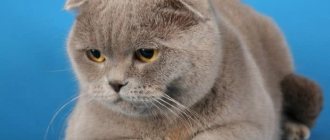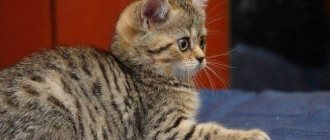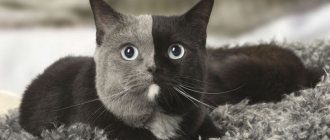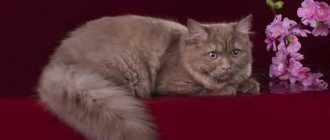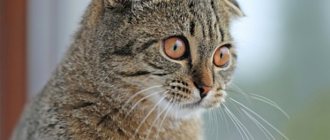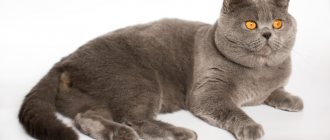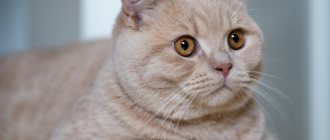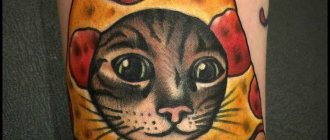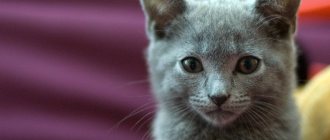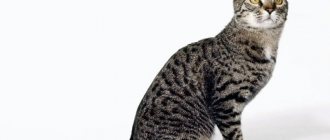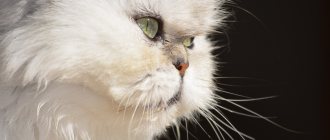Appearance
Standards for a British person's appearance were set in 1982. The model is considered to be a stocky animal with a wide chest, muscular body, strong rounded paws and short, plush-like fur. A feature of the breed is the presence of a rather large skin fold near the head. The nose is small, straight, wide.
Developed chin. The cheeks are plump and massive. The ears are small, neat, the same size in width and height. The medium-sized thick tail is rounded at the tip. The eyes are round, their color depends on the type of color of the breed. The average weight of a cat is from 3 to 5 kg, a cat - from 5 to 7 kg.
Breeding the British breed
The first British breed cats were introduced to the public in the 1870s. Breeders from among English gentlemen crossed the aboriginal cats of Great Britain with representatives of other breeds, mainly with Persians. Gradually, the kittens that were born acquired an expressive appearance, good health and tolerance towards all family members.
The popularity of the British grew. However, the Second World War that engulfed Europe destroyed the achievements of felinology, and the new breed of cats, popular at that time, became a rarity. To continue the work, it was necessary to eliminate inbreeding, so animals of other breeds were again used for mating. As a result, pets of new generations began to acquire Persian features.
Now felinological work is carried out within the framework of the accepted breed standard. However, in the bloodlines of different countries, some breed traits can be enhanced. Thus, among American breeders, a powerful, strong physique is valued. And at the European exhibition, the championship will be given to the pet in the most elegant coat.
Characteristic external signs
The British cat has a large, smoothly contoured head with well-defined cheeks. Wide cheekbones further emphasize the shape and fullness of the head. The nose is straight, thick and short, with a smooth transition to a round forehead. The chin is confident and strong, forming a vertical line with the nose.
Small, round, low, wide-set ears emphasize the robust appearance of the animal. The British are especially proud of their eyes: large, widely spaced. They carefully monitor everything that happens around them, even in those moments when the cat lies imposingly on a sun-drenched windowsill.
The pupils are always brightly colored: most are amber-copper, color-points are icy blue, and lilac and blue aristocrats are grass-green.
The massiveness of the silhouette is ensured by a squat body with low strong paws, a powerful chest, pronounced shoulders, and a thick tail. The coat is short, loosely fitting to the body. The entire coat is divided into a thicker coat and a dense undercoat.
Among the representatives of this breed, sexual dimorphism is well expressed. The weight of an adult cat ranges from 5 to 7 kg, of a female cat - from 3 to 5 kg. The average life expectancy is 12 - 15 years. However, from time to time in the media you can hear references to Britons who live to be 20 years or more.
White color and genetic characteristics
The white color of a British cat is characterized by snow-white fur without any inclusions or marks or smoke. In this case, newborn kittens may have a small spot, which should completely disappear by the age of one year.
This shade of fur should be uniform over the entire surface of the body; the presence of yellowness around the eyes, under the tail, and at the paw pads is excluded.
The nose, paw pads, eyelids, and the inner surface of the ears can only be pink. To encode white color, felinologists use the combination BRI W. Their meanings are:
- BRI W 61 - white British kittens with deep, intense blue eyes. Such animals often suffer from congenital deafness, which is transmitted at the genetic level.
- BRI W 63 - heterochromic British cats of white color. One eye of such animals is blue, the other is orange or copper.
- BRI W 64 - snow-white cats with green eyes.
- BRI W 62 - white color of British cats with orange eyes.
The W gene is responsible for the white coat color. Being dominant, it suppresses the genes of other colors present in the animal’s genetic makeup. It also determines the shade of the iris. As a result of blocking the pigment accumulation process, both eyes remain blue.
Also, the blue color can remain in only one eye, while the other eye is colored copper or orange by melanin. Occasionally, partial heterochromia occurs, in which two contrasting shades are combined in one cornea.
Such genetic combinations are “exclusive”, which is why heterochromic Britons are usually called “royal cats”, which are credited with the ability to bring good luck and prosperity to the home.
The principles of breeding within the British breed prohibit the mating of two individuals of the “BRI W” color. In this way, congenital deafness, which is transmitted by the dominant “W” gene, is prevented.
Breed colors
There are several shades of this cat breed, which are divided into:
- smoky;
- shaded;
- tortoiseshells;
- marble;
- two-color;
- monochrome.
A true White Briton has a cool, pure white coat tone without any splashes of yellow.
The skin is delicate, light pink in color. The eyes can be blue, orange or different colors.
Exterior
The breed standard describes the White British as follows:
- The head is round on all sides, the skull is wide, and there is a pronounced massive chin. The cheeks are round and dense.
- The nose is wide, short and straight.
- The ears are small and rounded. Low set.
- The eyes are large and round, blue, orange or heterochromic.
- The body is massive, with a developed chest and muscular frame.
- The limbs are short and strong.
- The tail is thick, with a rounded end.
- The weight of males is 4.5-8 kg, females - 2.5-5.7 kg.
- The color is perfectly clean and uniform.
The coat is thick and plush to the touch, lying close to the body. Thanks to the developed undercoat, the cat does not freeze in the cold. The white color looks unusual and beautiful, suggesting the complete absence of any other shades, spots, stripes, “smoky” hairs, or yellowness. Often found on the head, near the eyes, and at the base of the tail. A slight contrast is created only by pink paws and the tip of the nose.
Hairless cat breeds
The most aggressive and evil cat breeds
Smart cats: breed rating
Reference. The white British cat takes care of its fur more carefully than its counterparts. Scientists are sure that the cat is aware of its value, so it tries to maintain its snow-whiteness at the highest level.
Character
Cats are wary of strangers and will not allow themselves to be petted by anyone. The British are aristocratic in character and behave with dignity. By nature they are restrained, balanced, calm, self-sufficient. They do not require much attention and do not like abundant affection. The British white, like all representatives of this breed, is very clean. Sometimes they are called “business people’s cats”, as they easily and calmly endure the long absence of their owners and always greet them with joy. They love all family members very much and become attached to them.
We can say that these are smart animals, they don’t spoil furniture, don’t hang on curtains, don’t climb on tables, don’t get under your feet, but the unobtrusive Briton will always be next to you. They show absolutely no aggression. They are obedient and easy to train. They will never shit in the wrong place; they will sit and wait until the path to the tray is opened. If you suddenly forgot to put away meat or other products, then don’t worry, the Briton won’t touch them, but will sit by his bowl and wait.
The British cat is white in character - cold-blooded, like an Englishman, and cats are very shy. In unexpected situations they behave completely calmly.
Where to properly keep a pet and how to understand it
Representatives of the British Fold breed need space. It is best to keep them in country houses with their own yard or in large apartments. These plump cats are not very demanding on climatic conditions: they get used to heat or cold with equal ease.
See also the description of the British cat breed with photos.
It is worth understanding that, like all cats, British Folds are natural predators, so you should not feed them beyond the norm. Sometimes they can become greedy and eat all the treats you offer.
Representatives of this breed have a strong character, but are very sensitive to the praise and blame of the owner. So, after scolding your pet for being naughty, you can certainly notice him sitting somewhere in the distance, seemingly calmly licking his lips. In this way the animal tries to calm itself down.
Cats of this breed are very smart and quickly catch everything on the fly. One warning will be enough to once and for all discourage even a kitten from jumping on curtains or tables.
It is worth paying attention to the condition of the animal’s fur. If a cat licks itself until bald spots appear, it means that it is jealous of your new pet, to whom, in its opinion, you have begun to pay more attention than to it.
But if the fur is in an unkempt condition, you should contact a veterinarian. Your cat may be sick or have too much fur in her stomach.
British grooming
From childhood, kittens need to be taught hygiene procedures (grooming). Regularly examine the teeth, ears, eyes and care for the animal’s fur.
In the morning, a dark coating may appear in the corners of the eyes. It can be easily removed with a cloth dampened with water.
The fur enters the cat's stomach and settles inside in the form of lumps. In order to avoid blockage of the intestinal passages, from the age of 7 months the British dog must be accustomed to a special paste that helps dissolve the fur.
Grooming is simple:
- wash your pet no more than 2–4 times a year with a special shampoo, dry the coat with a hairdryer;
- Once a week, comb very carefully, without damaging the undercoat, remove dead hairs, it is best to use massage rubber brushes;
- during shedding, instead of combing, you should run a damp hand through the fur;
- The cat loves stroking against the growth of the fur.
Ears must be kept clean. If discharge appears, it is removed with a damp swab. The British have hairs growing on the tips of their ears; they are removed with scissors. The claws are inspected and trimmed once every two to three weeks. Every six months, worm prevention should be carried out with special preparations.
Questions and answers
How long do pregnant British Fold cats walk?
The pregnancy of British Fold cats lasts nine weeks. Animals need peace and support at this time. Try to provide your pet with a sufficient supply of vitamins to strengthen the body of the mother cat and her babies.
Why doesn't the British Fold cat walk?
Estrus in cats is an individual process. As a rule, it lasts about two weeks with a pause of up to six months.
If a cat does not walk for a long time, this can be caused by a number of reasons:
- hormonal disbalance;
- critical lack of vitamins (especially E);
- underdeveloped ovaries;
- quiet heat (the cat behaves very calmly).
Be sure to take your pet to the veterinarian to determine the reason for the absence of estrus.
What to do if your cat sheds a lot
Although British Folds are short-haired cats, they sometimes shed a lot. In summer, their thick undercoat thins noticeably.
However, in some cases, excessive shedding may be caused by:
- lack of vitamins (A, E) in food;
- hormonal disruptions in the adrenal, reproductive or thyroid gland systems;
- diseases of the epithelium (parasites, allergies, fungus, etc.);
- excessive stress.
If your cat's fur is falling out in clumps, contact your veterinarian, who will make a diagnosis and give advice on how to eliminate the specific problem.
However, it is worth knowing that British Folds shed almost all year round. Constant hair loss is just a sign of the breed.
How long do British Fold cats live?
Fold-eared beauties are known for their longevity. On average, these cats live 10-14 years, and with good care they can reach twenty years of age. They are naturally endowed with excellent immunity that can ward off many diseases.
If you pay enough attention to your pet’s health and provide it with the necessary vitamins, your pet will delight you for many years.
Now British Folds are classified as Scottish Folds, but many breeders hope to develop these beautiful animals into a separate breed. Perhaps these Cinderellas of the cat world have yet to win the hearts of people.
About caring for a Russian Blue cat is described in the article: Russian Blue cat.
How to care for the fur of a fluffy cat, see on the page.
Find out about hypoallergenic cat breeds for people with allergies from this information.
Description of kittens
Newborn white British kittens sometimes have a colored patch that disappears after the first year. This is not a flaw and is acceptable for this breed. Cats are caring mothers and spend all their time with their kittens. After a week, the eyes open. Starting from the third week, kittens can begin to be fed liquid food. Little Britons quickly become plump. They grow up slowly. Females reach their prime by age five. They live up to 20 years.
Little kittens are very similar to teddy bears, energetic from birth. Difference from other breeds:
- the kitten has a strong body, a wide chest and strong legs;
- round head, plump cheeks, rounded straight ears, round eyes of marsh or bluish-gray color; by the age of one year, the shade of the eyes changes;
- the tail is plump, thick and rounded at the very tip;
- thick wool of equal length approximately 2 cm.
In order to determine the gender of the kitten, you need to lay it on its back and feel the place under the tail.
The color of kittens varies, the most common are solid colors: black, red, cream, blue, lilac and white. Adult cats with these colors have amber or orange eyes. And only a white Briton (photo below) can have different colored eyes.
At the age of two to four months, kittens are very mischievous and can misbehave.
Real British
When wanting to buy a British kitten, future owners are always interested in the shape of its ears, whether they hang or stand straight.
The parents of a kitten of the British breed must be purebred British, and their ears stand straight up. There is no breed called the British Fold, white or any other color.
Kittens with floppy ears belong to a completely different breed of cat, which is called the Scottish Straight and has two types: straight-eared and fold-eared.
The line of Scottish Fold cats dates back to 1961, when one of them had a mutation, and her ears spontaneously drooped. The owner began to use selection methods and crossed her with ordinary cats. As a result, both fold-eared and straight-eared kittens were born. After a long selection, Scottish cats received their current appearance.
They differ from the British in appearance in the size and shape of the body, the length of the tail and paws, and the appearance of the ears, which fit tightly to the head, the tips of which are tilted forward and down. After mating a British female and a Scottish male with straight ears, the kitten is considered a Scottish breed.
History of the breed
The first mentions of Scottish fold cats appeared at the beginning of the 19th century. It was then that people paid attention to animals with interesting ears, which did not stick out, like many representatives of the cat world, but practically fit tightly to the head.
Photo: British Folds appeared quite recently, at the end of the 20th century
It was believed that such a cat, which later became the founder of the breed, was brought from distant China, but there was no written confirmation. But the story of a Scots shepherd’s cat, which had an unusual shape of ears, is known for certain.
It was from the kittens of this beauty that in 1961 the Rosse family bred offspring that became the ancestors of the Scottish Fold.
These animals appeared in Russia at the very end of the 20th century. There were very few furry Scots in the world back then. I had to mix with my British relatives.
Some babies were an exact copy of the Scots, while others were almost recognizable as British Shorthairs. The Fold cat from birth had the same eye color, quality of fur and some habits of its English ancestors.
Many amateur nurseries happily began breeding this beautiful animal. This is how the British Fold breed appeared, which still does not have official status.
Now many nurseries involved in breeding animals insist on recognition of extraordinary cats by international organizations.
Perhaps felinologists will soon make such a decision, but for now animals of this breed are generally considered to be Scottish Folds.
British white
The first feature of cats of this breed is the impeccable color of the skin. The coat is evenly colored throughout the pet's body. Secondly, only white British people have different colored eyes:
- Orange-rusty hue.
- It is quite rare to find cats with blue eyes. This eye color is considered a defect. Owners of such eyes do not participate in breeding offspring to preserve the breed. However, the white British dog with blue eyes is very popular among breeders.
- Both eyes are different colors. One is blue and the other is red. There is a belief that cats with such eyes bring good luck. They are also called "royal".
Caring for a white British dog is the same as for pets of other colors. It is periodically washed with special shampoos and combed out.
But they are very picky eaters. For lunch they should be served diced and lightly scalded raw meat.
Some sources are of the opinion that British dogs cannot be the same white color. The reason is that the risk of having deaf offspring increases. Other sources contradict these findings. British White is a rare coat color of this breed.
Scientific research shows that blue-eyed white Britons are often hard of hearing. And some argue that a cat's vision depends on the color of its coat. And its white color suggests that the cat has poor hearing. In fact, this is far from the case. Even a cat with blue eyes is not always deaf. If pets have different eye colors and one of them is blue, then the likelihood that he will be deaf is high. Although there are exceptions, and a white Briton with blue round eyes can hear.
Character and behavior
Because British Folds are a cross between a Scottish Fold and a British Shorthair, these plush pets embody the personality traits and demeanor of both breeds. See the description of the breed and character of the British Fold cat.
As a rule, boys are more British-like. They are self-sufficient, reserved and independent. They easily tolerate loneliness and do not like to be cuddled. However, they are not against communication; they like to play with teasers or balls.
Girls are much more gentle and friendly: they love their owner, adore children, and get along with other pets. A person allows himself to be carried in his arms, stroked, comes to sleep with him or lies on his lap when he sits.
They inherited one funny trait from their Scottish ancestors: they easily stand on their hind legs, looking for what attracts their attention.
These cats are extremely peaceful and patient. They are not aggressive, it is very difficult to anger them, and when this happens, the pet does not attack, but warns. They behave calmly with other animals in the house and will not be the first to get into a fight. If they are annoyed by another four-legged pet, then the British Fold will simply find a quieter place for itself.
Cats of this breed have another remarkable feature - they are extremely clean. They monitor the condition of their fur, claws and paw pads, removing the slightest dirt with great responsibility and diligence. If there are no conditions for putting itself in order, the pet will become extremely irritable and unsociable.
Despite their peaceful, slightly lazy lifestyle and love of being kept indoors, British Folds love to walk in the yard, practicing their hunting skills on a bird sitting on a branch or ground, unsuspecting insects or lizards.
A cat can patiently wait for a long time for an opportune moment to attack, watching from the grass or from a chosen elevation. They also don't mind climbing a tree and resting on a branch.
Cost of kittens
Specialized nurseries have a fairly large selection of British dogs. The cost of a kitten depends on its color and class:
- Show. Elite kittens of this class are an example of the British breed. Their cost starts from 40 thousand rubles.
- Breed. Kittens of this class have subtle flaws. They are mainly bought as future breeders of offspring, since with the right pair they can easily produce top-class kittens. The price starts from 22 thousand rubles.
- Pet. The British of this class have significant shortcomings and do not meet the requirements of the breed standard, although they are very beautiful kittens. They are bought as pets and as an affectionate friend. Cost - from 6 thousand rubles.
In the range of 3 to 5 thousand rubles you can buy a pet without a pedigree.
All pets, and especially the British white, love their owners and especially need reciprocal feelings.
